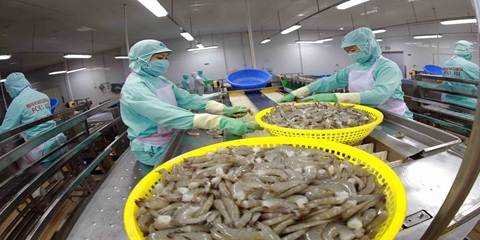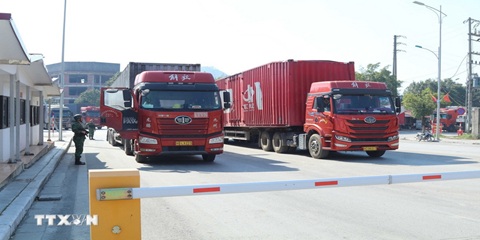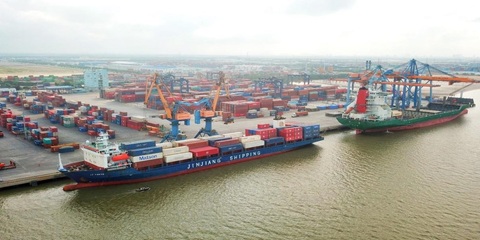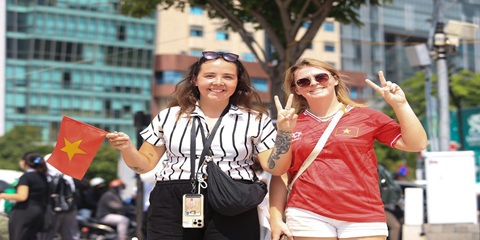Want to be in the loop?
subscribe to
our notification
Business News
GARMENT & TEXTILE INDUSTRY FACES A SLEW OF HARDSHIPS
TPP recession, rising costs, and rampant fabric smuggling are challenging the Vietnamese garment and textile industry, especially when the world is rushing with the Fourth Industrial Revolution.
Coping with difficulties
The Fourth Industrial Revolution has helped boost labour productivity, enhance product quality, and lower costs. But, it is forecast to cause layoffs in some labour-intensive industries like garment and textile and leather and footwear.
Mr Vu Duc Giang, Chairman of the Vietnam Textile and Apparel Association, said, automation, robot and big data can increase productivity at an exponential rate, not an arithmetic rate. Opportunities for the garment and textile industry are enhancing labour productivity and competitive prices while challenges are labour redundancy.
Mr Le Tien Truong, General Director of the Vietnam National Textile and Garment Group (Vinatex), analysed that if fibre and textile sectors had high speed of automation and advanced technological application from early and used less labour, the garment sector was different. As fashion products have difficult details and changing patterns, it will be much more difficult to automate production. Meanwhile, standard products with many fixed details or little changed details can be robotised.
Advanced technological application will raise labour productivity and employ less labour. Thus, the gap of labour costs in a product between developing and developed countries will be narrower. In addition, the Vietnamese garment and textile industry in the Fourth Industrial Revolution stage will face production redirected to the United States, the European Union (EU), Japan and South Korea which have cutting edge technologies and account for nearly 90 per cent of Vietnam’s total garment exports.
The garment and textile industry sector also faces hardships in labour costs. In 2016, wages of garment and textile workers went up 13 per cent, leading to overall costs to pick up.
The unstable world market, changing wage policy and worker mobility have posed the highest-ever barrier to the industry. In addition, curbed foreign exchange rates have also curtailed the competitiveness of garment enterprises.
Most Vietnamese garment companies are medium and small in scale. With limited market approach. They will hardly survive if they do not join hands with a big one, let alone stiff competition among peers and rivals.
Recommendations to the Government
Vinatex recently submitted a written proposal to the Prime Minister when it encountered a slew of difficulties. The group asked the Government to consider directing ministries and sectors to review and adjust master plans for development of labour-intensive industries to 2035, with a vision to 2050, which account for nearly 40 per cent of the country’s exports, to continue to be key exports of the nation.
Vinatex anticipated that the sector development orientation cannot catch up with long-term development and market changes. Supporting industries for the garment and textile industry are yet to develop, especially dyeing, weaving and fabric production (over 70 per cent of fabric is now imported), resulting in unbalances and vulnerabilities. It is very difficult to grow and develop cotton, mulberry, silkworm and some other material plants due to hard access to land and unlikeness of forming large production fields for mechanisation and high-tech application.
Leaders of some garment and textile producers asked the Government to pay attention to labour-intensive industries which are standing ahead of challenges triggered by the Fourth Industrial Revolution by introducing incentive policies that encourage companies to invest in cutting edge technologies. For example, they will be given tax cut if they use profits to invest in advanced technologies that keep up with the Fourth Industrial Revolution.
Accordingly, the government will also apply policies to encourage supporting industries to develop, attract domestic and foreign companies to make materials for garment and textile and leather and footwear industries. The government will have solutions and directions to have localities favour dyeing investment.
Vinatex also asked for permission to use its shares as security assets because its assets are primarily shares it holds in member companies in the capacity of a holding company. Whilst Vinatex’s shares are traded at many times higher than their par values, have high ROEs in many straight years, and are issued by big corporations like Viet Tien Garment Joint Stock Corporation, Hoa Tho Garment Textile Joint Stock Corporation and Hue Garment Textile Joint Stock Company, Vinatex thus asked the Prime Minister for permission to use its shares as security assets.
In addition, Vinatex proposed the Government consider lowering the rate of social insurance premiums to ease growing pressures on expenses for wages, personnel, production and competition.
The group also asked the Government to direct relevant bodies to have business support policies, with a focus placed on effective credit access. Accordingly, interest rates will be further slashed to near the rates of other countries in the region in order to boost production while relaxing borrowing conditions and/or launching credit packages for SMEs. The forex policy needs to support exports.
Last but not least, Vinatex requested the Government to direct relevant ministries and branches to carry out drastic measures to keep smuggling at bay and thwart tax evasion to protect domestic producers which are struggling to fight against rampantly smuggled fabrics and materials.
Source: VCCI
Related News

VIETNAM’S SEAFOOD EXPORTS HIT OVER US$10 BILLION IN JAN-NOV
Seafood export revenue in November alone amounted to nearly US$990 million, up 6.6% year-on-year. Key product groups posted solid gains. Shrimp exports rose 11.7% to over US$385 million, supported by strong demand for whiteleg shrimp and lobster. Tra fish shipments increased 9.7% to almost US$197 million, while marine fish, squid, and mollusk exports maintained their recovery.

VIETNAM’S AGRO-FORESTRY-FISHERY EXPORTS HIT NEW RECORD IN JAN-NOV
Vietnam’s agro-forestry-fishery export revenue reached an estimated US$64.01 billion in the first 11 months of 2025, up 12.6% year-on-year and surpassing the full-year record of US$62.4 billion set in 2024. Agricultural exports reached US$34.24 billion, up 15% year-on-year, while livestock products brought in US$567.4 million, a 16.8% increase. Seafood exports rose 13.2% to US$10.38 billion, and forestry products earned US$16.61 billion, up 5.9%.

HANOI REPORTS RECORD-HIGH BUDGET REVENUE IN 2025
Hanoi’s budget revenue is estimated to reach VND641.7 trillion in 2025, the highest level ever recorded and nearly 25% above the revised target, according to a report by the municipal government. Data from the city’s socioeconomic performance review shows that total state budget collections in 2025 are projected to reach 124.9% of the adjusted plan and rise 24.9% from 2024, the Vietnam News Agency reported.

VIETNAM, CHINA TO PILOT TWO-WAY CARGO TRANSPORT AT LANG SON BORDER
Vietnam and China will launch a one-year pilot program on December 10 to allow two-way cargo transport through the Huu Nghi–Youyi Guan international border gates in Lang Son Province, reported the Vietnam News Agency. The Dong Dang-Lang Son Economic Zone Management Board said the trial aims to reduce transport costs and improve customs clearance capacity.

VIETNAM’S IMPORT-EXPORT VALUE NEARS US$840 BILLION IN JAN-NOV
The total value of Vietnam’s imports and exports was nearly US$840 billion between January and November this year, the highest level ever recorded, according to the National Statistics Office. In its latest report on the country’s socio-economic performance, the National Statistics Office highlighted a series of positive economic indicators, with trade emerging as one of the strongest drivers of growth.

OVER 19 MILLION INTERNATIONAL VISITORS COME TO VIETNAM IN JAN-NOV
Vietnam received more than 19.1 million international visitors in the first 11 months of 2025, a 20.9% increase year-on-year and the highest level ever recorded, according to the National Statistics Office. The figure surpasses the full-year record of 18 million arrivals set in 2019, before the Covid-19 pandemic. Nearly two million foreign visitors arrived in November alone, up 14.2% from October and 15.6% from the same period last year.
























